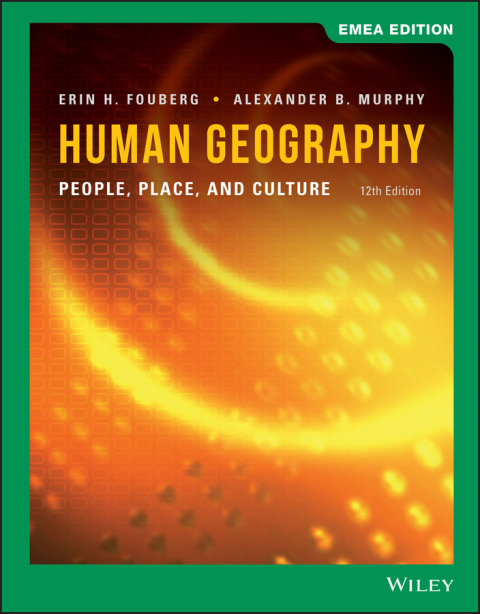Description
Efnisyfirlit
- Cover
- Preface
- Acknowledgments
- About the Authors
- CHAPTER 1 Introduction to Human Geography
- 1.1 Define Human Geography and Describe the Value of Thinking Geographically.
- 1.2 Identify and Explain Geography’s Core Concepts.
- 1.3 Identify types of maps and examine the role maps play in understanding the world.
- 1.4 Describe How Culture Influences Patterns and Processes in Human Geography.
- Summary
- Self-Test
- CHAPTER 2 Population and Health
- 2.1 Describe the Patterns of Population Distribution.
- 2.2 Identify and Explain Influences on Population Growth over Time.
- 2.3 Explain How Health and Disease Affect Peoples’ Well-Being.
- 2.4 Identify Why and How Governments Influence Population Growth.
- Summary
- Self-Test
- CHAPTER 3 Migration
- 3.1 Explain Migration as a Type of Movement.
- 3.2 Explain Historic and Modern Forced Migration.
- 3.3 Explain the Theories of Migration and Understand the Motivations for Migration.
- 3.4 Identify Why Refugees Are a Distinct Group of Migrants and Describe Where Most Refugees Migrate.
- 3.5 Determine How Government Policies Impact Migration.
- Summary
- Self-Test
- CHAPTER 4 Local Culture, Popular Culture, and Cultural Landscapes
- 4.1 Explain Local Cultures and Popular Culture.
- 4.2 Understand How People Sustain Local Cultures in Rural and Urban Areas.
- 4.3 Explain How Global, Popular Culture Is Created and Diffused.
- 4.4 Compare and Contrast How Local and Popular Cultures Are Reflected in Cultural Landscapes.
- Summary
- Self-Test
- CHAPTER 5 Identity: Race, Ethnicity, Gender, and Sexuality
- 5.1 Define Identity and Explain How Identities Are Constructed.
- 5.2 Determine How Place Affects Identity and How We Can See Identities in Places.
- 5.3 Explain the Role Structures of Power Play in Shaping Identities.
- Summary
- Self-Test
- CHAPTER 6 Language
- 6.1 Define Language and Describe the Role of Language in Culture.
- 6.2 Explain How Languages Are Related and Distributed.
- 6.3 Explain How Language Can Be Used as a Unifying or Dividing Force.
- 6.4 Determine the Role Language Plays in Making Places.
- Summary
- Self-Test
- CHAPTER 7 Religion
- 7.1 Describe the Nature of Religion and Its Cultural Significance.
- 7.2 Describe the Distribution of Major Religions and the Factors That Shaped Their Diffusion.
- 7.3 Explain How the Cultural Landscape Reflects Religious Ideas and Practices.
- 7.4 Identify and Describe the Role Religion Plays in Political Conflicts.
- Summary
- Self-Test
- CHAPTER 8 Political Geography
- 8.1 Compare and Contrast States, Nations, and Nation-States.
- 8.2 Determine How the Modern Political Map Evolved.
- 8.3 Explain the Nature and Significance of International Boundaries.
- 8.4 Explain Classical and Critical Geopolitics.
- 8.5 Compare and Contrast Supranational Organizations and States.
- Summary
- Self-Test
- CHAPTER 9 Urban Geography
- 9.1 Describe the Sites and Situations of Cities.
- 9.2 Analyze the Distribution of Cities and Their Relative Size.
- 9.3 Explain the Internal Structure of Cities and Compare Urban Models.
- 9.4 Analyze How Political and Economic Policies Shape Cities.
- 9.5 Explain What World Cities Are and Describe How They Shape and Reflect Globalization.
- Summary
- Self-Test
- CHAPTER 10 Development
- 10.1 Explain How Development Is Defined and Measured.
- 10.2 Describe the Nature and Limitations of Development Models.
- 10.3 Explain Major Influences on Development.
- 10.4 Evaluate How Political and Economic Institutions Influence Uneven Development Within States.
- Summary
- Self-Test
- CHAPTER 11 Agriculture
- 11.1 Compare and Contrast the Three Agricultural Revolutions.
- 11.2 Describe the Spatial Patterns of Agriculture.
- 11.3 Explain the Map of Global Agricultural Production.
- 11.4 Analyze How Commercial Agriculture Operates.
- 11.5 Examine the Challenges of Feeding Everyone.
- Summary
- Self-Test
- CHAPTER 12 Industry and Services
- 12.1 Describe the Hearth and Diffusion of the Industrial Revolution.
- 12.2 Explain How and Why the Geography of Industrial Production Has Changed.
- 12.3 Explain Global Patterns of Industrial Production.
- 12.4 Determine How Deindustrialization and the Rise of Service Industries Have Changed the Economic Geography of Trade.
- Summary
- Self-Test
- CHAPTER 13 The Humanized Environment
- 13.1 Explain What Natural Hazards Are and How Natural Hazards Can Become Natural Disasters.
- 13.2 Identify the Ways That Humans Impact Earth Through Land Use, Water Use, and Resource Extraction.
- 13.3 Explain How Climate Change Is Impacting Human–Environment Interactions.
- 13.4 Explain How Human Consumption Is Changing the Scale of Human Impact and Challenging Sustainability.
- Summary
- Self-Test
- CHAPTER 14 Globalization and the Geography of Networks
- 14.1 Describe How Identities Are Changing in a Globalized World.
- 14.2 Identify Networks and Explain Their Role in Globalization.
- 14.3 Explain How Social, Information, and Economic Networks Operate in a Globalized World.
- Summary
- Self-Test
- Appendix A Maps
- Map Scale
- Map Projections
- Map Symbols
- Appendix B Area and Demographic Data
- Appendix C Answers to Self-Tests
- Appendix D References
- Glossary
- Index
- Wiley End User License Agreement






Reviews
There are no reviews yet.